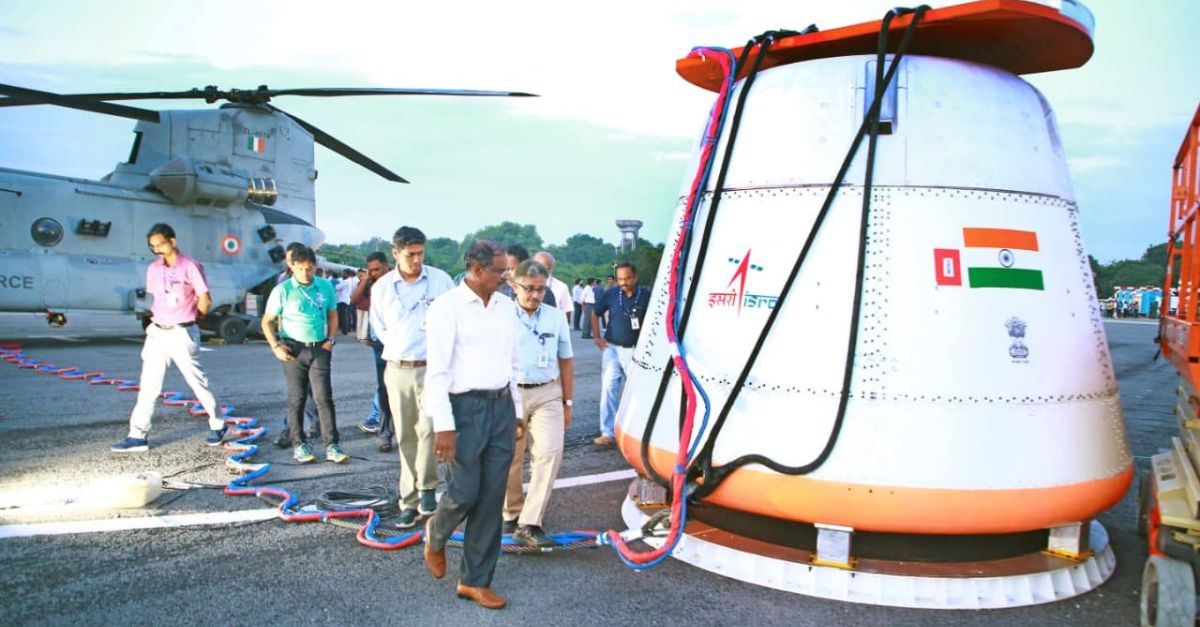- By Yashashvi Tak
- Sun, 24 Aug 2025 04:30 PM (IST)
- Source:JND
The Indian Space Research Organisation (ISRO) on Sunday has successfully conducted its first Integrated Air Drop Test (IADT-01), a crucial test to validate the parachute system that will ensure astronauts’ safe return under the Gaganyaan mission, conducted from the Sriharikota spaceport.
The trial was conducted with the help of multiple defence and research organisations, including the Indian Air Force, Defence Research and Development Organisation (DRDO), Indian Navy, and Indian Coast Guard. In the test, a mock crew module was released from an aircraft and safely brought down using a specially designed parachute system. The successful landing confirmed that the parachutes functioned as intended.
ALSO READ: What Is IADWS, India's Latest Air Defence Weapon System Successfully Tested By DRDO | Key Points
In a post on X, ISRO wrote, "ISRO successfully accomplishes first Integrated Air Drop Test (IADT-01) for end-to-end demonstration of parachute-based deceleration system for Gaganyaan missions. This test is a joint effort of ISRO, Indian Air Force, DRDO, Indian Navy and Indian Coast Guard."
What Is Integrated Air Drop Test ( IADT-01) ?
The IADT-01 was designed to test the complete set of parachutes intended to slow and stabilise the crew module during re-entry and splashdown of the human spaceflight mission. The system includes two drogue parachutes for initial deceleration, followed by pilot chutes and three main parachutes to ensure a safe descent.
Earlier, Union Minister of State for Science and Technology Dr Jitendra Singh stated that the development and ground testing of the Human Rated Launch Vehicle (HLVM3) for India’s first human spaceflight programme, Gaganyaan, have been successfully completed.
ISRO successfully accomplishes the first Integrated Air Drop Test (IADT-01) for an end-to-end demonstration of the parachute-based deceleration system for Gaganyaan missions. This test is a joint effort of ISRO, Indian Air Force, DRDO, Indian Navy and Indian Coast Guard
— ANI (@ANI) August 24, 2025
Source:… pic.twitter.com/4vPLHLXs3H
"Orbital Module: The Propulsion systems for Crew Module and Service Module have been developed and tested. ECLSS engineering model realised. Crew Escape System (CES): 5 types of motors developed and static tested. Infrastructure established: Orbital Module Preparation Facility, Gaganyaan Control Centre, Gaganyaan Control facility, Crew training facility, Second Launch pad modifications," Singh said in a written reply in the Lok Sabha.
"Precursor Missions: A Test Vehicle developed for validating CES and flight tested in TV-D1. Activities are in progress for TV-D2 and IADT-01. Flight Operations and Communication Network: Ground network configuration finalised. IDRSS-1 feeder stations and terrestrial links established. Crew Recovery Operations: Recovery assets finalised. The Recovery Plan worked out. First Uncrewed Mission (G1): C32-G stage and CES motors realised. HS200 Motors and CES Fore end up with Crew Module Jettisoning Motor stacked. Crew Module and Service module structure realised. Crew Module Phase-1 checks completed," he added.
Gaganyaan Mission
1. The Gaganyaan Programme is a stepping stone toward developing a human habitat or space station in low Earth orbit for longer missions.
2. India’s long-term vision includes the Bharatiya Antariksha Station (BAS) by 2035 and a Moon landing by 2040.
3. Plans are underway to establish five modules of the BAS, with approval already obtained for the development of the first module.
4. Mission aspects, launch vehicle configuration, and orbital module systems for the Moon landing are being developed in line with the 2040 goal.
5. Training modules are designed incrementally to support both the ongoing Gaganyaan programme and the future Moon mission, aligned with mission timelines.
ALSO READ: Mumbai Metro Lines 2A And 7 Timings Extended Till Midnight For Ganeshotsav 2025; Check Details
ISRO’s Second Test Vehicle Demonstration
In addition to the IADT tests, the space agency is gearing up for the second Test Vehicle Demonstration (TV-D2) and the first uncrewed Gaganyaan mission (G1), both crucial steps toward India’s inaugural human spaceflight.
